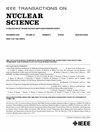Proton, Electron, and Photon Flux Measurement and Simulation During Stratospheric Balloon Flights
IF 1.9
3区 工程技术
Q3 ENGINEERING, ELECTRICAL & ELECTRONIC
引用次数: 0
Abstract
This article compares three models of the atmospheric radiative environment: 1) model of atmospheric ionizing radiative effects (MAIREs); 2) Excel-based Program for calculating Atmospheric Cosmic-ray Spectrum (EXPACS); and 3) radiation atmospheric model for single-event effect simulation (RAMSEES) to experimental fluxes measured at different altitudes. The PIX Centre National d’Etudes Spatiales (CNES) instrument recorded the fluxes during five stratospheric flights. There is no standard way to model the atmospheric radiative environment today. Each model uses its own Monte Carlo toolkit, modeling the atmosphere and primary particles. The RAMSEES was created by Geant4 simulation of the Extensive Air Shower (EAS) phenomenon generated by highly energetic Galactic Cosmic Rays (GCRs) in 100 km of atmosphere. By using PIX fluxes, this article aims to benchmark the models with experimental data at multiple altitudes. Three integral fluxes were used in this article at a comparison point: 1) photons >0.823 MeV; 2) electrons >10.27 MeV; and 3) protons >80 MeV. MAIRE shows good agreement with all the experimental fluxes from 5 to 40 km. MAIRE predictions show remarkable agreement with the PIX photon fluxes. EXPACS predictions are in a magnitude order of PIX measurements but tend to underestimate the fluxes. Finally, RAMSEES predictions agree with PIX fluxes for protons, electrons, and photons at altitudes of 5–32.5 km. Moreover, RAMSEES shows significant agreement with PIX proton fluxes.平流层气球飞行期间质子、电子和光子通量测量与模拟
本文比较了三种大气辐射环境模型:1)大气电离辐射效应模型(MAIREs);2)基于 Excel 的大气宇宙射线频谱计算程序(EXPACS);3)用于单次事件效应模拟的辐射大气模型(RAMSEES)和在不同高度测量的实验通量。国家空间研究中心的 PIX 仪器在五次平流层飞行中记录了通量。目前还没有标准的大气辐射环境建模方法。每个模型都使用自己的蒙特卡罗工具包,对大气和原生粒子进行建模。RAMSEES 是通过 Geant4 模拟 100 公里大气层中高能银河宇宙射线(GCR)产生的大范围空气淋浴(EAS)现象而创建的。通过使用 PIX 通量,本文旨在用多个高度的实验数据对模型进行基准测试。本文使用了三种积分通量作为比较点:1)大于 0.823 MeV 的光子;2)大于 10.27 MeV 的电子;3)大于 80 MeV 的质子。MAIRE 与 5 至 40 千米范围内的所有实验通量都显示出良好的一致性。MAIRE 的预测结果与 PIX 光子通量非常吻合。EXPACS 的预测值与 PIX 的测量值在一个量级上,但往往低估了通量。最后,RAMSEES 的预测结果与 PIX 在 5-32.5 公里高度的质子、电子和光子通量一致。此外,RAMSEES 与 PIX 的质子通量有显著的一致性。
本文章由计算机程序翻译,如有差异,请以英文原文为准。
求助全文
约1分钟内获得全文
求助全文
来源期刊

IEEE Transactions on Nuclear Science
工程技术-工程:电子与电气
CiteScore
3.70
自引率
27.80%
发文量
314
审稿时长
6.2 months
期刊介绍:
The IEEE Transactions on Nuclear Science is a publication of the IEEE Nuclear and Plasma Sciences Society. It is viewed as the primary source of technical information in many of the areas it covers. As judged by JCR impact factor, TNS consistently ranks in the top five journals in the category of Nuclear Science & Technology. It has one of the higher immediacy indices, indicating that the information it publishes is viewed as timely, and has a relatively long citation half-life, indicating that the published information also is viewed as valuable for a number of years.
The IEEE Transactions on Nuclear Science is published bimonthly. Its scope includes all aspects of the theory and application of nuclear science and engineering. It focuses on instrumentation for the detection and measurement of ionizing radiation; particle accelerators and their controls; nuclear medicine and its application; effects of radiation on materials, components, and systems; reactor instrumentation and controls; and measurement of radiation in space.
 求助内容:
求助内容: 应助结果提醒方式:
应助结果提醒方式:


